#Teppozu Inari Shrine
Explore tagged Tumblr posts
Photo










寒中禊水浴大会 - 鉄砲洲稲荷神社, 湊, 中央区, 東京 Winter purificatory bath - Teppozu Inari Shrine, Minato, Chūō/Chūō-ku, Tokyo
118 notes
·
View notes
Text
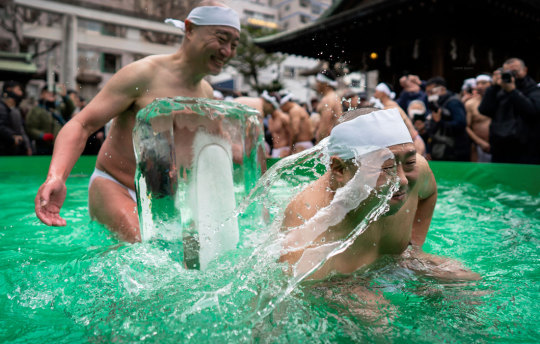
Traditional ice-cold bathing in the courtyard of the Teppozu Inari Shinto Shrine in Tokyo
0 notes
Text
Weekend treat: try to have a tour of Toyosu Market and revisit the place where I stayed before my study abroad at age 16 on our way to the temple and an aquarium shop in Tsukiji!
4/5/2024(Day3 during the Golden Week)
Having walked from the subway station to Toyosu Fish Market in the blazing sun despite May, my parents and I were already exhausted even before we arrived. However, I found the sky this area grander for some reason and felt refreshed myself. Even though I've lived in Japan since I was born, I had never been to Tsukiji nor Toyosu Fish Markets, which I had been feeling sort of inferior to. That was why I came here. Yet, unfortunately, the market was being closed on the day; I should have confirmed its opening time beforehand. Collecting myself, I decided to explore a newer facility next to the market called Senkyakubanrai(千客万来), a seafood and hot-spring complex themed Edo period, instead.
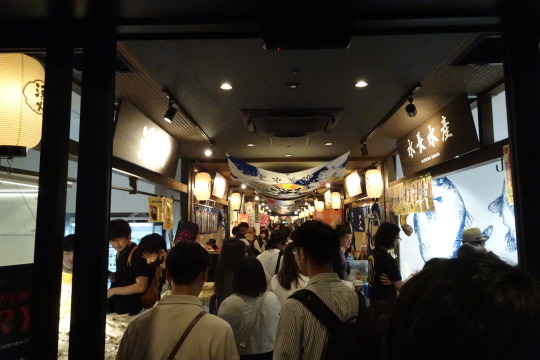
After we split up for their lunch at a certain restaurant, I hung around the facility for an hour alone. It was really packed to the brim with people from around the world inside, and every single restaurant including a food court had a huge line; I speculated that most of the people lining up in there had to wait more than an hour. The proximity in terms of space and relationship between customers and shopkeepers did bring about a lively atmosphere like I expected the fish market to throughout this complex. I totally enjoyed that although I didn't eat there.
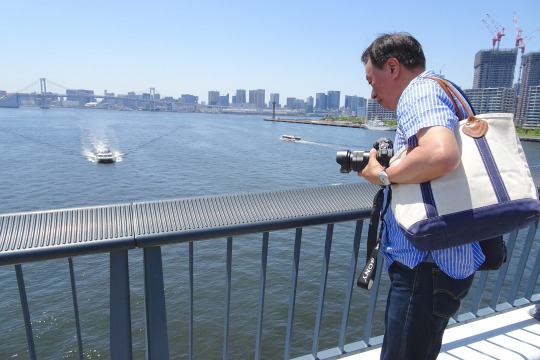
No sooner had I met up with my parents around noon than we headed over to an area which I had been keen to revisit. This waterfront relies on many bridges, which I regard as one of the charms. Dad and I were pleased with the view from Toyosu Bridge and had fun waving people on deck.

The accommodation above is mostly for training sessions and little known; but I still do remember the few days when I stayed here for the pre-departure orientation in my high school days(almost a decade ago)although that turned out a nightmare. At any rate, it was so satisfactory that I could recall how hard I would exert myself to pursue my dream then and feel the days glorious enough to make me energetic again.

In addition, I asked my folks to accompany me there. This place is a mere mall next to the accommodation, yet also one of my retrospective spots in Tokyo regarding my study abroad. Before heading to the hotel for the orientation, I said farewell to mom at the mall. Once I entered the building, all my fragmented memories as to this were put together, and feelings that I couldn't name were evoked. Compared to the touristy spot I mentioned first, this local shopping place wasn't that prosperous, but I took to the quietness, a mix of a metropolis and a suburb, and its European design including a garden, which I could see a strong commitment by everyone involved through.

Next up, I went to Tsukiji Hongwanji Temple, a Buddhist temple belonging to the Jodo Shinshu, founded by the monk Shinran, located in the heart of Tokyo since 1679, because I was curious about its famous architecture. At the time, the event featuring Tibet was being held.
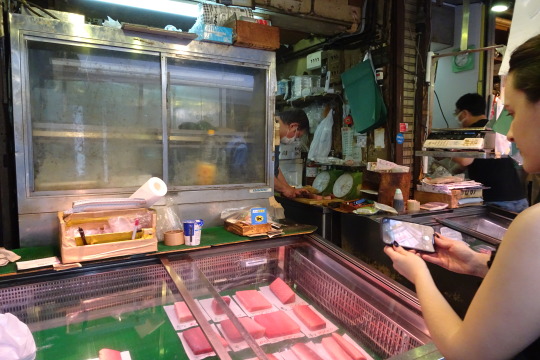
In place of Toyosu Fish Market, I managed to feel a certain atmosphere and make the best out of a fish market through Tsukiji Outer Market. There seemed chaos in a good way, and all my senses were vigorously activated like catching fishy smell while passing through the streets to the point where I felt like I wasn't in Japan anymore.
After that, we bumped into a kind of religious parade/festival and its participants carrying a mikoshi, a portable mini shrine that houses a god, on our way to an aquarium shop in the neighborhood. Actually, that was my very first time to see a mikoshi in person(side note: according to the official website, the festival was held by Teppozu Inari Shrine).
Last but not least, I finally arrived at Paupau Aqua Garden(パウパウアクアガーデン), a large-scale aquarium shop in Ginza. I've been fond of goldfish since I was in high school somehow and tend to be more excited at tropical fish than penguins of some kind in aquariums. Then, I learned several species through its display, such as celestial eye goldfish and humpback grouper. Overall, I think I did experience Toyosu area to the fullest by walking across bridges, looking out to the ocean, feeling the light breeze, smelling fish or monja, and encountering the so-called matsuri.

#weekend treat#short trips#tokyo#japan#golden week#toyosu#edo period#bridges#tsukishima#tsukiji#walking tour#festival#sushi#crowded#mikoshi#fish market#tropical fish#retrospect#tsukiji hongwanji#sightseeing
0 notes
Photo
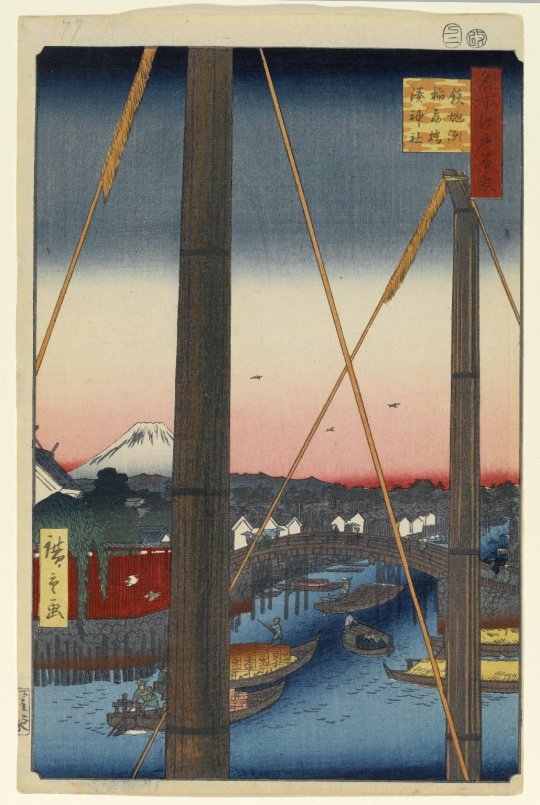
Inari Bridge and Minato Shrine, Teppozu, No. 77 from One Hundred Famous Views of Edo, Utagawa Hiroshige, 2nd month of 1857, Brooklyn Museum: Asian Art
This particular place, where the Kyobashi River entered Hatchobori (Eight-Cho Canal) was where the large ships from western Japan were anchored and their cargoes were transformed into small lighters for distribution to the quays and storehouses that lined the canals. In the foreground are the masts of two cargo ships and in the background are the lighters heading into the warehouse-lined canal. The Minato (Harbor) Inari Shrine lies half-hidden at the left behind a red fence and was one of the oldest shrines in Edo. It survives today as well as Inari Bridge. Blue "bokashi" covers much of the sky and there is overprinting on the foreground masts. In the center there is a narrow strip of blue "bokashi" on the water. Size: Sheet: 14 3/16 x 9 1/4 in. (36 x 23.5 cm) Image: 13 3/8 x 8 3/4 in. (34 x 22.2 cm) Medium: Woodblock print
https://www.brooklynmuseum.org/opencollection/objects/121691
14 notes
·
View notes
Photo

Inari Bridge and Minato Shrine, Teppozu (Teppozu Inaribashi Minato Jinja), from the series "One Hundred Famous Views of Edo (Meisho Edo hyakkei)", Utagawa Hiroshige, 1857, Art Institute of Chicago: Asian Art
Frederick W. Gookin Collection Medium: Color woodblock print; oban
https://www.artic.edu/artworks/34308/
10 notes
·
View notes
Text



Teppozu-inari shrine, Minato
4 notes
·
View notes
Text
Japan Leaning Towards Ending Tokyo State of Emergency on March 21
Japan Leaning Towards Ending Tokyo State of Emergency on March 21
Participants wearing protective face masks amid the coronavirus disease (COVID-19) outbreak, pray as they take an ice-cold bath during a ceremony to purify their souls and to wish for overcoming the pandemic at the Teppozu Inari shrine in Tokyo, Japan, January 10, 2021. REUTERS/Kim Kyung-Hoon Restrictions such as shorter business hours for restaurants and bars have helped reduce new daily cases…

View On WordPress
0 notes
Photo





富士塚 1 小さな富士山と東京の写真集 FUJIZUKA 1 SMALL MOUNDS FUJI AND TOKYO Photo Book
築地鉄砲洲稲荷神社 鉄砲洲富士 中央区湊 1-6-7 Tsukiji teppozu inari Shrine Teppozu Fuji 1-6-7, Minato, Chuo-ku
Google+ https://plus.google.com/105927364264306621006/
23 notes
·
View notes
Photo

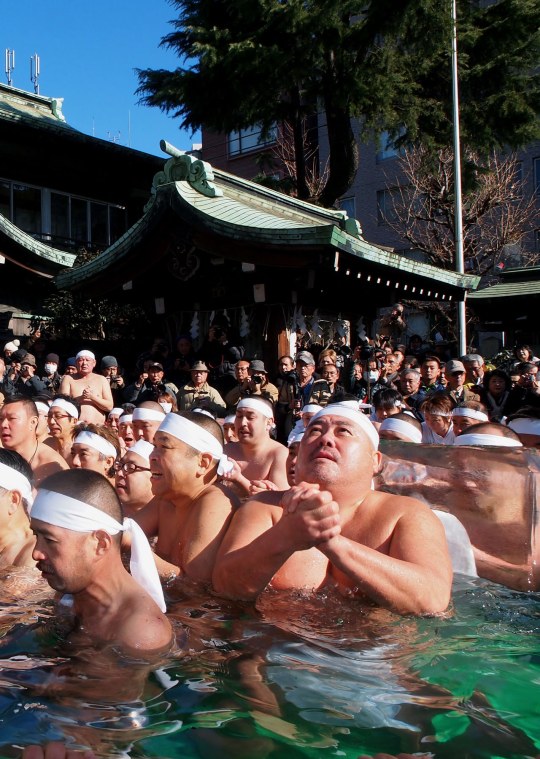
寒中禊水浴大会 - 鉄砲洲稲荷神社, 湊, 中央区, 東京 Winter purificatory bath - Teppozu Inari Shrine, Minato, Chūō/Chūō-ku, Tokyo
29 notes
·
View notes
Photo

Some hundred participants took part in this ice water endurance purification ceremony at Teppozu Inari Shrine in Tokyo. The ceremony is an effort to purify the body and soul for the new year. 📷 Christopher Jue, European Pressphoto Agency https://usat.ly/2D48sqb #newyear #purification #tokyo #japan #prayer http://ift.tt/2EH2Oe3
0 notes
Text
Picture of the Day › Chilly dip
Picture of the Day › Chilly dip
People wearing loin cloths pray as they bathe in ice-cold water outside the Teppozu Inari shrine in Tokyo on Sunday. The temperature was 7 degrees in Tokyo on Sunday. According to organizers, about 100 participants took part in the Shinto ceremony to purify their souls and wish for good health… Source: japantoday
View On WordPress
0 notes
Text
[su_label type=”info”]The gallery of “One Hundred Famous Views of Edo”[/su_label]
In 1853, Utagawa Hiroshige began to draw the new series of landscape ukiyo-e. He already held the position of pupular ukiyo-e artist by the succuess of “Fifty-Three Stages on the Tokaido“. His new work was on the theme of sights in various parts of the Edo.
As its name suggests, “One Hundred Famous Views of Edo” consists of more than 100 paintings(and table of contents). And the they are divided into four seasons.
Table of contents
Spring
[su_spoiler title=”‘One Hundred Famous Views of Edo’ Spring”]
Clearing Weather after Snow at Nihonbashi
Kasumigaseki
Yamashita-chō and Outer Sakurada Gate
Tsukuda Island from Eitai Bridge
Ekōin, the Ryōgoku District, and Moto-Yanagi Bridge
Hatsune Riding Grounds, Bakuro-chō
Cotton goods shops, Ōdenma-chō
Suruga-chō
Yatsukōji, inside Sujikai Gate
Dawn at Kanda Myōjin Shrine
Kiyomizu Hall and Shinobazu Pond at Ueno
Yamashita (“Beneath the Mountain”) District, Ueno
Hirokoji Street in Shitaya
Temple Gardens, Nippori
Suwa Bluff, Nippori
Flower Pavilion, Dango Slope, Sendagi
View to the North from Asukayama
Ōji Inari Shrine
Dam on the Otonashi River at Ōji
The Kawaguchi Ferry, Zenkōji Temple
Mount Atago, Shiba
Furukawa River, Hiroo
Chiyogaike Pond, Meguro
New Fuji, Meguro
Moto Fuji, Meguro
Armor-Hanging Pine, Hakkeisaka
Plum Garden, Kamata
Palace Hill, Shinagawa
Moto-Hachiman Shrine, Sunamura
Plum Estate, Kameido
Azuma Shrine and the Entwined Camphor
Yanagishima
Towboats Along the Yotsugi-dōri Canal
Night View of Matsuchiyama and San’ya Canal
Suijin Shrine and Massaki on the Sumida River
View from Massaki of Suijin Shrine, Uchigawa Inlet, and Sekiya
Tile Kilns and Hashiba Ferry, Sumida River
Dawn Inside the Yoshiwara
Distant View of Kinryūzan Temple and Azuma Bridge
Bashō’s Hermitage and Camellia Hill on the Kanda Aqueduct at Sekiguchi
Ichigaya Hachiman Shrine
Blossoms on the Tama River Embankment
[/su_spoiler]
Summer
[su_spoiler title=”‘One Hundred Famous Views of Edo’ Summer”]
Nihon and Edo Bridges
View of Nihonbashi Road 1-chōme
Yoroi Ferry and Koami-chō
Seidō Hall and Kanda River from Shōhei Bridge
Fūdo Falls, Ōji
Paulownia Plantation, Akasaka
Zōjōji Pagoda and Akabane
Sumiyoshi Festival, Tsukuda Island
Mannen Bridge, Fukagawa River
Sudden Shower Over Ōhashi Bridge and Atake
Ryōgoku Bridge and the Great Riverbank
Rendezvous Pine near the Asakusa River and the Onmaya Bank of the Sumida River
Komagata Hall and Azuma Bridge
Horikiri Iris Garden
Precincts of the Tenjin Shrine, Kameido
Sasakai Ferry
Open Garden at Fukagawa Hachiman Shrine
Mouth of the Naka River
Scattered Pines beside the Tone River.
Eight-view Bridge
Suido Bridge and Suruga Hill
Twelve Kumano Shrines at Tsunohazu
Entrance of the Sanno Festival Procession to Kōjimachi
Kōjimachi and the Benkei Moat at Soto-Sakurada
The Parting Waters at Mitsumata
The Asakusa River, Miyato River, and the Banks of the Sumida River
Ayase River and Kanegafuchi
The Snail Hall at the Temple of the Five Hundred Arhats
Hall of Thirty-Three Bays, Fukagawa
[/su_spoiler]
Autumn
[su_spoiler title=”‘One Hundred Famous Views of Edo’ Autumn”]
Prosperity Throughout the City during the Tanabata Festival
Clothing Shop, Odenmacho
he Dyers’ District in Kanda
Kyobashi Bridge and Bamboo Yards
The Harbor Shrine and Inari Bridge at Teppozu
Teppōzu and Tsukiji Honganji Temple
Shinmei Shrine and Zōjōji Temple in Shiba
Kanasugi Bridge and Shibaura
Ushimachi, Takanawa
Moon-Viewing Point
Susaki and Shinagawa
Grandfather’s Teahouse, Meguro
Distant View of Akasaka Pond from Kinokuni Slope
The New Station of Naitō at Yotsuya
Benten Shrine and Inokashira Pond
River of waterfalls, Ōji
The Moon Pine on the Temple Precincts at Ueno
Night view of Saruwaka-chō
Inside Akiba Shrine, Ukechi
Mokubōji Temple and Vegetable Fields by the Uchi River
Nījuku Ferry
Maple Leaves, the Tekona Shrine, and Bridge at Mama
View of Goose Hill and the Tone River
Horie and Nekozane
Five Pines, Onagi River
Fireworks at Ryōgoku
[/su_spoiler]
Winter
[su_spoiler title=”‘One Hundred Famous Views of Edo’ Winter”]
Kinryūzan Temple, Asakusa
Nihon Embankment, Yoshiwara
Asakusa rice fields and Torinomachi Festival
Mikawa Island, Kanasugi, and Minowa
The Great Bridge at Senju
Koume (“small plum”) Embankment
Onmayagashi
Fukagawa Lumberyards
Susaki and the Jūmantsubo Plain near Fukagawa
View of the Bay at Shiba
Minami-Shinagawa and Samezu Coast
Robe-Hanging Pine, Senzoku Pond
Drum Bridge and Sunset Hill, Meguro
Yabu Lane Below Atago
Aoi Slope, Outside Toranomon Gate
Bikuni Bridge in the Snow
Takada Riding Grounds
Sugatami Bridge, Omokage Bridge, and Jariba at Takada
Hilltop View, Yushima Tenjin Shrine
New Year’s Eve Foxfires at the Changing Tree
[/su_spoiler]
Back to the page of Utagawa Hiroshige
Hiroshige’s “One Hundred Famous Views of Edo” The gallery of "One Hundred Famous Views of Edo" In 1853, Utagawa Hiroshige began to draw the new series of landscape…
0 notes
Text
Hundreds Seek Good Health in Ice Bath During Tokyo’s Annual Shinto Ritual
Reuters, Jan. 11, 2016
Men wearing traditional loin cloths and women clothed in white robes chant before entering an ice water bath during a Shinto ritual at the Teppozu Inari Shrine to purify the soul and wish for good health in the New Year.
Hundreds took part in the annual event, now in its 61st year, which is held on the second Sunday of each year.
“I bathe in this ice water every year to dispel evil thoughts,” said Tomio Hashimoto, who took part in the ritual for the fourth consecutive year.
0 notes
Photo
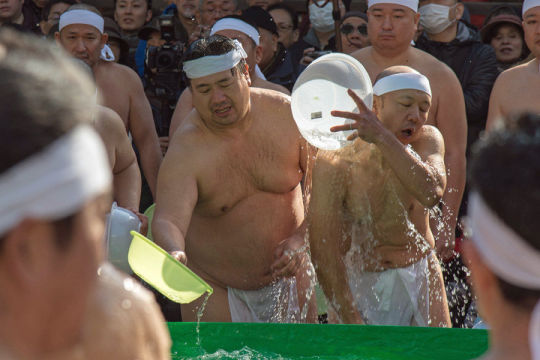
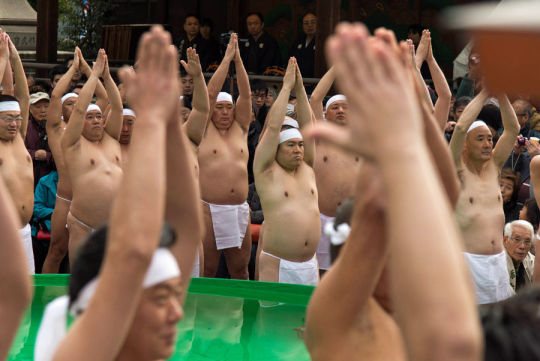
寒中禊水浴大会 - 鉄砲洲稲荷神社, 湊, 中央区, 東京 Winter purificatory bath - Teppozu Inari Shrine, Minato, Chūō/Chūō-ku, Tōkyō
28 notes
·
View notes
Photo

寒中禊水浴大会 - 鉄砲洲稲荷神社, 湊, 中央区, 東京 Winter purificatory bath - Teppozu Inari Shrine, Minato, Chūō/Chūō-ku, Tōkyō
26 notes
·
View notes
Photo

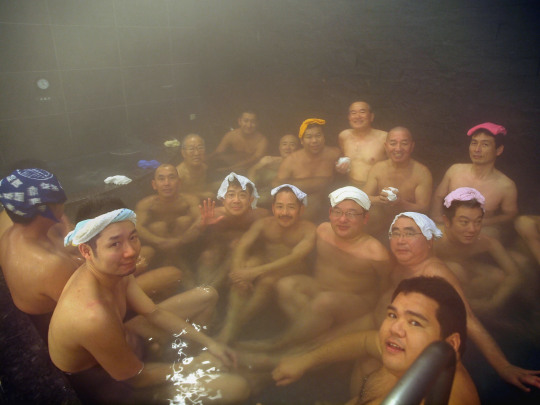

寒中禊水浴大会 - 鉄砲洲稲荷神社, 湊, 中央区, 東京 Winter purificatory bath - Teppozu Inari Shrine, Minato, Chūō/Chūō-ku, Tokyo
26 notes
·
View notes